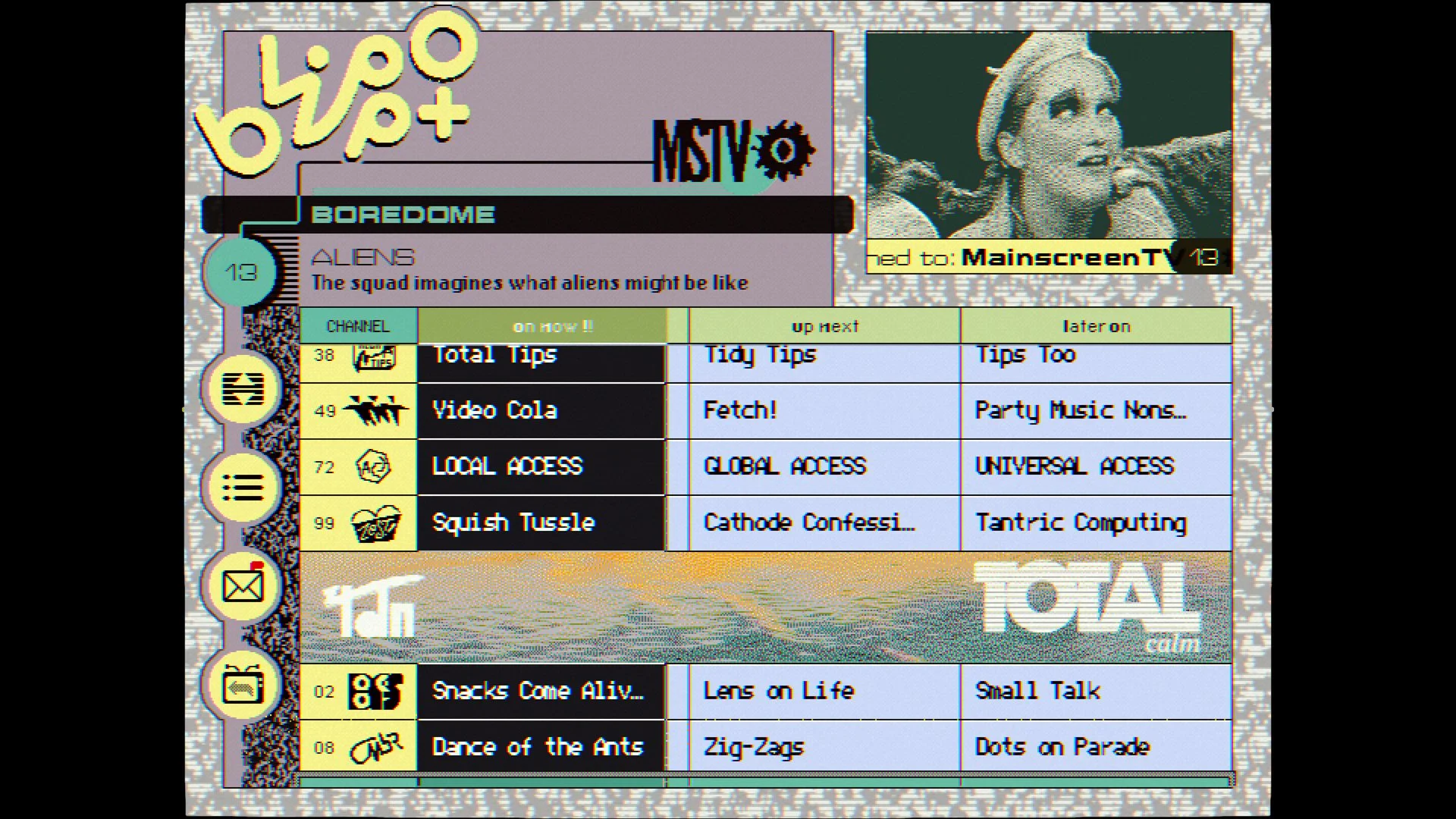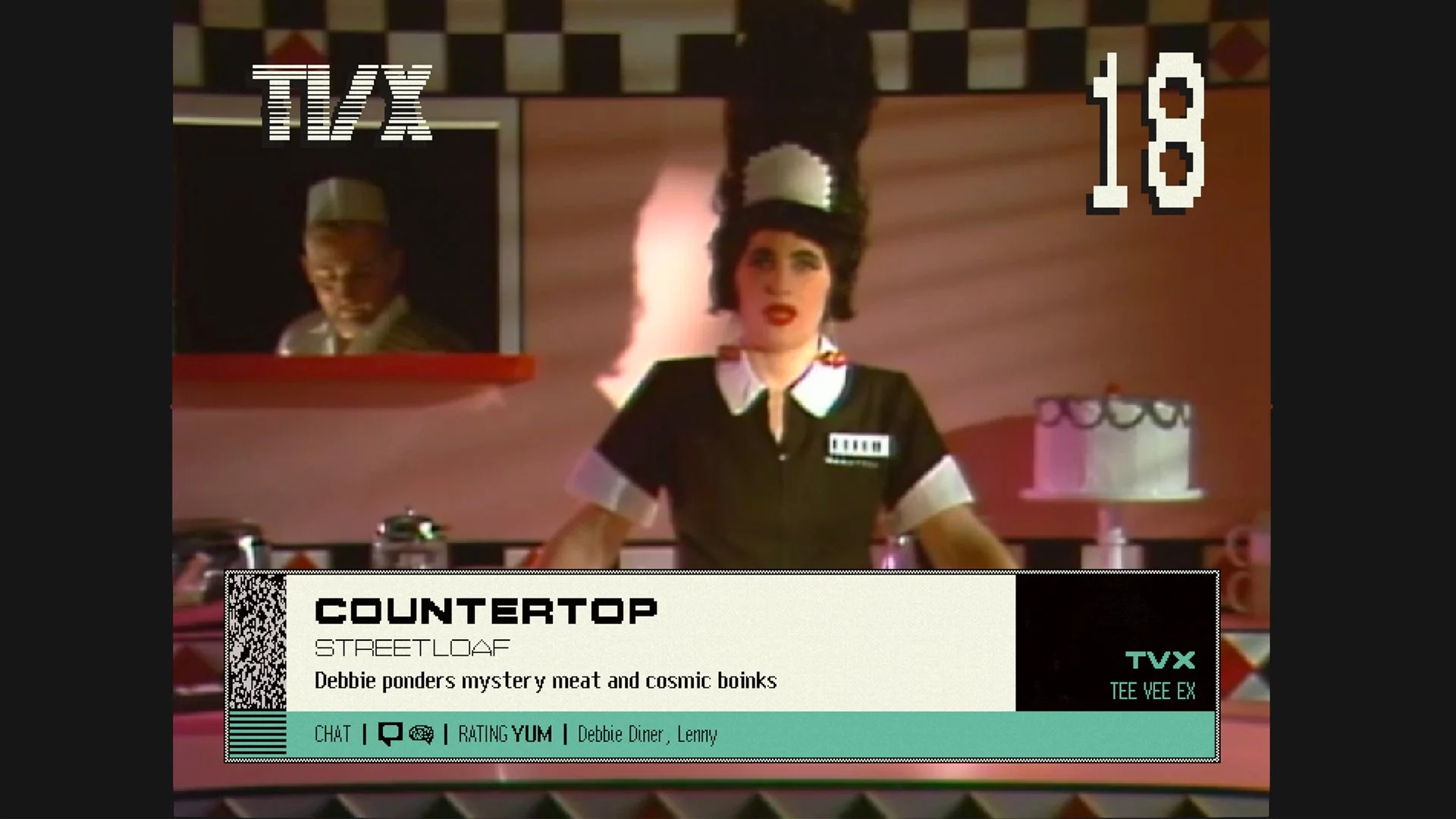Review | Blippo+ - A Planet Left Too Soon
I haven’t watched television programming in years, aside from the odd Adult Swim animated show from time to time (more on that later). But when I came across Blippo+, a 1980s-1990s new wave television simulator, I thought the idea was hilarious and clever.
Developed by YACHT, Telefantasy Studios, Dustin Mierau, and Noble Robot, Blippo+ takes place on the planet Blip. Blippians, beings similar to humans, are zany and hyper-optimistic. I wondered how the game would parody talk shows, sitcoms, food — what do Blip’s politics consist of, for that matter? I will say, I was a bit surprised by the game’s twists and turns.
This isn’t a typical narrative game with fail states or multiple branching paths and endings per se. In Blippo+, you channel-surf your way through the Planet’s stations rendered in full-motion video, unlocking new episodes once you view all the content on each channel. Gradually you’ll uncover a storyline involving the eccentric Blippians as they showcase their culture through television.
Blippo+ exudes a weird new wave cable television aesthetic. It commits to the bit, including retro video fidelity. The game’s music includes a mixture of ‘80s and ‘90s new wave, funk, and pop. Sometimes, the music sounds like ‘90s kids’ TV shows, like the Rugrats or Reading Rainbow. The “hub” where you select channels to watch is a TV Guide-esque scrolling menu. It and other UI elements have a grungy 1990s MTV meets Sonic The Hedgehog menu look to them.
Navigating through Blippo+ is pretty straightforward. Most of the time you’ll be watching shows and switching channels with the mouse or arrow keys. Occasionally, you’ll go back to the TV Guide to view listed channels, or go to mail notifications to access messages and updated channel packages. At the time of this review, the game doesn’t display prompts for the keyboard controls, but the PC version accepts keyboard inputs, of course. A mechanic Blippo+ lacks but could have benefited from is a pause, rewind, and fast forward button. Just in case you missed an important detail a few seconds ago, you want to revisit your favourite moments on different channels, or you need to step away from the computer. Bringing up the menu with the escape key won’t pause any of the clips — your only choice is to wait it out. There is one meta game mechanic that involves the player tuning the signal so the scrambled static goes away. It’s not complex, and it doesn’t happen too often. But it may be slightly pesky if, again, you need to step away from the game for a bit, as over a period of time, the game will lose its “signal”.
The game’s content is quite Adult Swim–coded. It’s characterised by dry, ironic humour, and late-night acid-trippy randomness. The shows are also bite-sized, each lasting a few minutes, and cover a variety of creative experiences. There are scripted fictional shows, variety talk shows, documentaries, and cooking shows that dive further into how Blippians live their lives. I found myself enjoying The Rubber Report, Do You Party, Boredome, The Psychic Weather Report, and Femtofax the most.
Do You Party is a mail-in show where host Poly Pixel reads questions that Blippians ask about their outer space neighbours. She’s slightly flirtatious while presenting mail with a fun colourful background behind her. Her clothes are the best example of trendy Blippian fashion, involving ‘80s attire, spiky makeup, and a splash of futuristic accesories.
Psychic Weather is hosted by Barbara Lightworker. She’s a lady with three eyes who forecasts the emotional vibes in Blippian areas. Barbara introduces the weather report as if she wants the viewers to get out of their seats and start dancing for the next musical guest. Even during turbulent moods she encourages positivity. She made reporting the “weather” so badass she became my favourite character.
My favourite show on Blippo+ is Boredome. It’s a show where Blippian teens talk about the news from their perspective. It reminded me of Nick News, a ‘90s show that did something similar. The show’s cast of teens really capture the essence of being relentlessly awkward, yet somehow cool, adolescents from another planet, and Boredome ends up being a driving force behind the shifts of the game’s story.
Other standouts include Brain Drain, a show where a scientist interviews historical figures by uploading their consciousness through their brains, as well as commercials for The Fighting Trillians, a show about diverse weapon wielding femme fatales with cool names like Chronica Cassette.
For me, two shows fell flat: Confetti Cowboys and Subroutines. Confetti Cowboys’ two spacefaring cowboys discussed menial tasks and had intimate conversations, but their discussions weren’t that interesting or insightful and conflicts resolved pretty quickly even considering the short length of the episodes. Subroutines stars dancers dressed in yellow gear and glasses who perform a routine to the beat of silly robotic nursery rhyme–sounding music. Unfortunately it all came across a bit too hokey, and you are forced to watch the same episode on each channel update.
Blippo+ features a diverse cast, which I definitely appreciated. This includes LGBTQ+ representation, which is both shown by how characters are presented visually and in the writing itself. During my playthrough, I noticed a gay black man talking about a love interest in an episode of Wurf’s Tavern. We’re on other planets too! On a related note, the TV simulator incorporates characters who engage in different professions and hobbies, including food service, journalism, fine arts, astronomy, and more.
Blippo+ consistently conveys an upbeat demeanour with a lot of its content. But there is a moment in the story where the planet’s discovery of space travel is marred by concerning events. This causes people online and on TV to have clashing views with each other. Certain shows are also affected. My heart dropped a little when the story took this turn. Then it fluttered when I saw how some characters became part of a radical movement that embraces the space phenomenon. Several shows constantly gave me warm fuzzy feelings from the enthusiasm and relatable weirdness the Blippians portrayed. You see a very small glimpse of what happens to a few people within the radicalised movement, but not much else. So as magnetic and endearing as the shows and characters are, the underlying story ends abruptly and vaguely.
Overall a full playthrough — or watch-through — of Blippo+ takes about 20 hours. Its comedic programming features lovable and surprisingly badass characters, and the worldbuilding within the shows and forums piece together to form an engaging story. But a few of the shows, and the “end” of the story fall short, leaving me wanting more. Nevertheless, I’ve already found myself revisiting some of Blip’s shows. If you enjoy retro 1980s 1990s TV, especially science fiction, or you’re a fan of FMV storytelling, Blippo+ might be for you.








